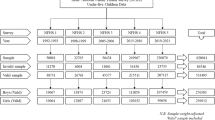Abstract
Objective: To study the current diet and nutritional status of rural adolescents in India.
Design: Cross-sectional study with household as the unit of randomization.
Setting: National Nutrition Monitoring Bureau collected information in the rural areas of the nine States.
Methods: In each State, 120 villages were selected from eight districts. From each of the selected villages, 20 households (HHs) were selected from five clusters. The information on socio-demographic profile was collected in all the 20 HHs, while anthropometric data such as weight, height and clinical signs of nutritional deficiency was collected on all the available adolescents in the selected households. In every fourth sampled household, ie five HHs, dietary information on all the members was collected using 24 h dietary recall. The outcome measures for nutritional status were proportion of underweight (<median −2 s.d. of NCHS standards of weight for age), stunted (<median −2 s.d. of NCHS standards of height for age) and body mass index. The nutrient intakes were compared with recommended dietary allowances (RDA).
Results: Anthropometric and socio-economic information on 12 124 adolescent boys and girls and dietary information on 2579 individuals in 1996–1997 was available for the analysis. The major occupation of the heads of the households surveyed was agriculture. More than a third (37.3%) of the families with adolescents did not possess any land. The per capita income per month was about Rs 250/- at 1996–1997 prices. About 23% of the adolescent girls were married before the age of 18 y. About a quarter of the married adolescent girls had short stature and 18.6% were underweight. They considered as ‘at risk’. About 39% of the adolescents were stunted (<Median −2 s.d. of NCHS height for age) irrespective of sex. The prevalence of undernutrition (<median −2 s.d. of NCHS weight for age) is higher (53.1%) in boys than in girls (39.5%). The extent of stunting was higher (42.7%) among adolescents belonging to the scheduled caste community. In the case of girls, the extent of underweight was considerably less in each age group than their male counterparts. About 70% of adolescents consumed more than 70% of RDA for energy. The intakes of micronutrients such as vitamin A and riboflavin were woefully inadequate.
Conclusions: The extent of undernutrition was high among adolescents and was higher among boys than girls. Adolescent girls in the rural areas could be at greater risk of nutritional stress because of early marriage and early conception before completion of their physical growth.
This is a preview of subscription content, access via your institution
Access options
Subscribe to this journal
Receive 12 print issues and online access
$259.00 per year
only $21.58 per issue
Buy this article
- Purchase on Springer Link
- Instant access to full article PDF
Prices may be subject to local taxes which are calculated during checkout
Similar content being viewed by others
References
Agarwal KN, Tripathi AM, Sen S, Kaliyar GP . 1974 Physical growth and adolescence Ind. Paediatr. 11: 93–97
Expert Group of ICMR. 1981 Recommended Dietary Intakes for Indians. New Delhi: Indian Council of Medical Research
Expert Group of ICMR. 1990 Nutrient Requirements and Recommended Dietary Allowances for Indians. New Delhi: Indian Council of Medical Research
Gopalan C, Ramasastry BV, Balasubramanyam SC, Narasinga Rao BS, Deosthale YG, Pant KC . 1990 Nutritive Value of Indian Foods. Hyderabad: National Institute Of Nutrition
Hamill PVV, Drizd TA, Johnson CL, Reed RB, Roche AF, Moore WM . 1979 Physical growth: National Centre for Health Statistics percentiles Am. J. Clin. Nutr. 32: 607–629
Jelliffee DB . 1966 Assessment of the nutritional status of the community. WHO Monograph Series no. 53. Geneva: WHO
National Nutrition Monitoring Bureau. 1999 Report of Second Repeat Survey–Rural (1996–1997). Hyderabad: NIN
Nutrition Foundation of India. 1989 Growth of affluent Indian girls during adolescence. Scientific Report no. 10, pp 41–48 New Delhi: Nutritional Foundation of India
Siegel S . 1956 Non-parametric Statistics for the Behavioural Services. New York: McGraw-Hill
Vijayaraghavan K, Singh D, Swaminathan MC . 1971 Heights and weights of well nourished Indian School Children Ind. J. Med. Res. 59: 648–654
WHO. 1995 Physical status: the use and interpretation of anthropometry. WHO Technical Report Series no. 854. Geneva: WHO
Author information
Authors and Affiliations
Corresponding author
Rights and permissions
About this article
Cite this article
Venkaiah, K., Damayanti, K., Nayak, M. et al. Diet and nutritional status of rural adolescents in India. Eur J Clin Nutr 56, 1119–1125 (2002). https://doi.org/10.1038/sj.ejcn.1601457
Published:
Issue Date:
DOI: https://doi.org/10.1038/sj.ejcn.1601457
Keywords
This article is cited by
-
Socio-economic, demographic, and familial correlates of physical activity and dietary practices among adolescent boys in Bihar, India
Journal of Public Health (2023)
-
Prevalence of mental health problems among rural adolescents in India: A systematic review and meta-analysis
Scientific Reports (2022)
-
Low head circumference during early childhood and its predictors in a semi-urban settlement of Vellore, Southern India
BMC Pediatrics (2019)
-
Institutional Imperatives for Promoting Trees Outside Forests (TOFs) to Enhance Timber Production in India
Small-scale Forestry (2019)
-
Identification of dietary patterns by factor analysis and study of the relationship with nutritional status of rural adolescents using factor scores
Journal of Health, Population and Nutrition (2015)



